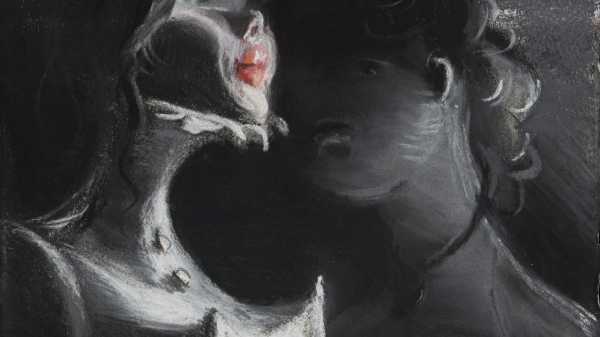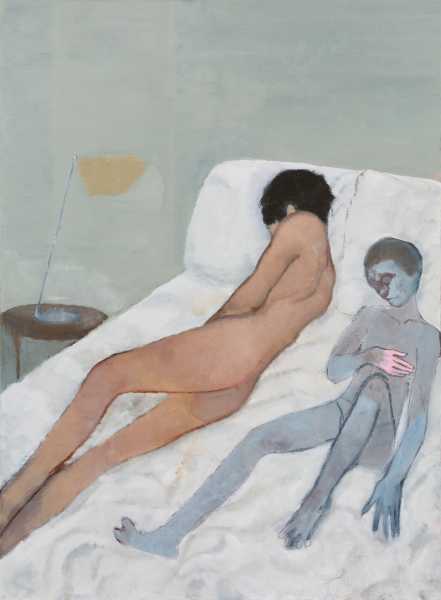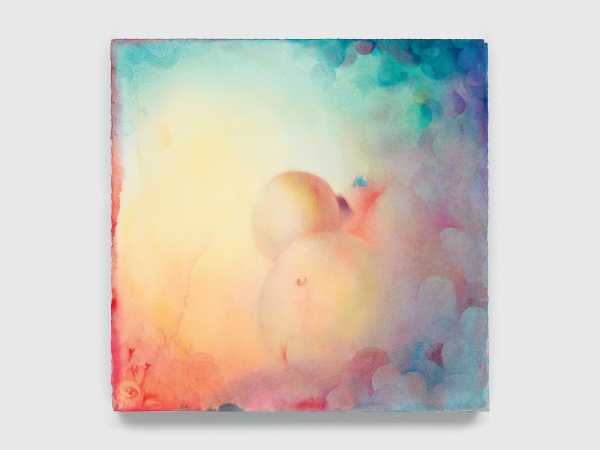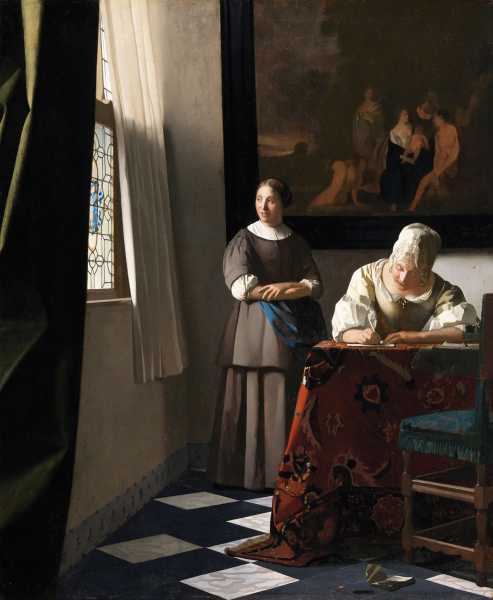
Save this storySave this storySave this storySave this story
I think that sometimes, when we look at art, we’re hoping to recapture a piece of our past—a golden time when we had a deep and unforgettable experience with a painting, a photograph, or a drawing, when we were struck not only by its beauty but by its power to make us feel included in the world, less alone. Growing up, I pored over the black-and-white images in the Vogue photographer Irving Penn’s second book, “Worlds in a Small Room.” Originally published in 1974, the book is a testament to Penn’s interest in the importance and the intimacy of place. Setting up temporary studios in Morocco, San Francisco, and New Guinea, among other locations, he focussed his patient, detail-oriented eye on the ways in which we declare a self. I remember being transfixed by an image of Peruvian children in floppy hats leaning against a stool, and by one of three young women from Dahomey, attired in beautifully tied headdresses and minimal jewelry. What I loved about the book—though I was not capable of articulating this then—was that Penn’s photographs weren’t framed by “difference.” He was interested in his subjects because they were interesting, as compelling as the white hippie family he met in California in the late sixties, and the beauties who struck attitudes before his camera for Vogue for decades. It seemed to me that “Worlds in a Small Room” had nothing to do with “universality,” the ethos that Edward Steichen tried to generate with his problematic MOMA exhibition, “The Family of Man,” in 1955; rather, it addressed the thrill of specificity, how Penn’s subjects’ dress and adornment said as much about the way they wanted to be perceived as about where they came from.

“Cold,” 2025.Art work by Sanya Kantarovsky / Michael Werner Gallery
A lot of the art that has garnered attention in recent years has been outward-looking, a critique of a world that doesn’t meet the artist’s expectations. And, while I’ve learned a great deal from that work, I’ve also yearned for what Virginia Woolf describes in her novel “Jacob’s Room” as the “spiritual suppleness” of the kind of intimacy in which “mind prints upon mind indelibly.” That was what I saw in those Penn photographs, and what I saw in recent months, too, in a number of shows, in which artists seemed to be exploring the smaller worlds found in rooms. It started in the late spring, with Sanya Kantarovsky’s (now closed) show “Scarecrow,” at Michael Werner. Kantarovsky was born in Moscow in 1982 and immigrated to the U.S. at the age of ten. I knew very little about him when I went to see the show, and at first I didn’t know what to do with the feelings his work engendered, because they opened a door to vulnerability that I was only partially aware I had locked. The first piece I noticed was a small painting of spiders, which reminded me too much of Louise Bourgeois’s terrifying and corny constructions; I didn’t see the point of it, aside from being a lovely exercise in color. But then I got to the large-scale canvas “Cold” (2025), and realized that by painting those arachnids, who use their webbed homes to trap living sustenance, Kantarovsky was expressing something about our own ways of luring people into our private spaces and then perhaps betraying them. In “Cold,” which measures seventy-five by fifty-five inches, we see a long-legged, salmon-colored nude person on a bed, facing away, black hair resting against a white pillow. We do not know the person’s gender, nor that of the other, smaller figure in the bed, whose face shows the anguish of that turned back with an expression that hints at grievance, disappointment. That sad, perplexed figure is painted blue—the blue of melancholy, the blue of Joni Mitchell’s album “Blue” (1971), with its “Underneath the skin / an empty space to fill in”—and is all of us: the rejected child, the forlorn lover, all in one. That blue soul’s right hand is pink, and rests on their chest, over the heart. Its glow is the glow of remembrance, of a touch that is fading, in the room in which these figures are locked, silent, while communicating so much, the modern lamp beside them illuminating their intimacy as it breaks apart.
The bodies on display in “Lisa Yuskavage: Drawings” (at the Morgan Library through January 4th) are studies in attention, which, as the poet Mary Oliver said, is the “beginning of devotion.” For more than thirty years now, Yuskavage has been devoted to using the tools of art to produce an imagined wonderland of bodies. Her paintings are gardens of possibility in which women are portrayed across the spectrum from the kind of fuck dolls that capitalism wants women to be to strong, independent selves whose defiance tells viewers to fuck off. Yuskavage’s paintings are generally large-scale, filled with light and color and a kind of good will, so it’s fascinating and enlivening to see, at the Morgan, how her themes play out in the more modest arena of drawings.
Curated with flair and insight by the Morgan’s Claire Gilman, the show is organized in one of the museum’s smaller rooms, and the close space only enhances the rapport you feel with the art itself, which has the delicacy of spun glass. Yuskavage draws with the authority of a master, and, like any master, she keeps refining what her hand is capable of and what her eye sees. There are forty-one works in this exhibition, and they don’t drown one another out. The drawings in color are equal to those in pencil or charcoal, but show different things, including how shading effects a mood, and how, if you edge close to losing control of a watercolor—a medium that requires concentration and a more than deft hand—you can take it to new levels of delicious finesse. That’s what you’ll find in the incredible “Rapture #2” (1993), which shows a white woman’s torso and breasts rising out of a galaxy of circles and bubble shapes reminiscent of a ball pit—a fun place to jump into and roll around in. The light source is to the left of the canvas, and it shines through softly, like the promise of a good day.
Here and elsewhere, I felt the influence of Hans Bellmer’s “Dolls” photographs, but Yuskavage’s figures don’t live in the isolation of her mind or her studio in the way that Bellmer’s do; she’s too interested in how bodies interact with other bodies and themselves. There’s a sweetness to the erotic yearning in “Love Scene” (1993), a small watercolor on paper, in which the focus is on a mouth, a tongue, and a nipple. We see only the tip of the tongue as it reaches to taste the nipple, which curves upward. Below this world of desire, Yuskavage has painted, very faintly, a hilly landscape with trees. The juxtaposition of images in a single frame, so to speak, feels natural within the context. Similarly natural is the wonderful “Lauren Sleeping” (2011), a walnut ink, gouache, and pastel drawing. Walnut brown is the dominant color here, and you want to get up close to the image because it’s like looking at an old sepia photograph of a private moment, which might reveal something—but what? Its mysteries are part of what makes it such a powerful piece. We can’t see Lauren’s face, not exactly, but her body is a presence. She sits at a table, her breasts resting on it. Her left hand also rests on the table, while her head—she has short hair, with bangs—leans against her right hand, her right elbow propped on the table. These various shapes—the horizontal and vertical, the round and the straight—are important to Yuskavage; line and form make drama in an image, and what’s wrong with a little drama?

“Rapture #2,” 1993.Art work by Lisa Yuskavage / Courtesy the artist and David Zwirner
But sometimes the drama of the self is enough. In “Dysfunctional Dancer” (1994), the lone figure is a white woman with small, upward-pointing breasts. She wears patterned underwear, and she is looking outside the frame, at something we cannot see. Presumably, her arms are clasped behind her back, but we only see a bit of her left arm. Also, her ballet slippers look almost like fins. Is she a landlocked mermaid singing a siren song? And what is she staring at? I like to think she’s looking at the artist, that other figure in the room who is fully engaged by her imagination.
Walking into “Vermeer’s Love Letters” (at the Frick, through August 31st) is like stepping into a dream, or the sweet reality, of love. The great painter’s art has everything to do with the senses, with how we open ourselves up to beauty and why. Perhaps this is odd to say, given that the exhibition is centered on the production of language—letter-writing—but the language stops there, and Vermeer takes over, challenging the very idea that words can measure up to image-making.
The show has three astonishing paintings: the Frick’s “Mistress and Maid” (1664-67); “The Love Letter” (c. 1669-70), from the Rijksmuseum, in Amsterdam; and “Woman Writing a Letter with Her Maid” (c. 1670-72), from the National Gallery of Ireland. But before I saw those three paintings I stopped to look at two in the Frick’s permanent collection, which are also currently on display: “Officer and Laughing Girl” (1657-58) and “Girl Interrupted at Her Music” (1659-61). At first, I was embarrassed by my reaction to the former painting. No matter how long I stood in front of it, I couldn’t see it, not clearly, so overwhelmed was I by the brilliance of the eros I found in it. That pink-cheeked, white-bonneted young maid sitting to the right of the picture frame, her hands folded demurely around a glass of wine on a table: is the soldier who sits across from her the sole source of her delight? Has he tried with her before and failed? Are they getting a little drunk together? (Some scholars have suggested that she is a prostitute with a client, a familiar theme in seventeenth-century Dutch painting.) And who is he, her dark-haired young visitor, sporting a wide-brimmed beaver-felt hat, his hand resting suggestively on his red-coated hip. He’s the worst kind of flirt—confident and unafraid to be a little femme himself, with some red adornments, possibly flowers, tucked into his hat. Who chose them? For a long time, I couldn’t get past that rakish black brim; I stayed in its gorgeously rendered darkness. Eventually, the map hanging on the wall above the couple and the light from the open window helped pull me away. The map is of Holland; the blue indicates land, not water; and the window offers a view of the outside world that we cannot see. Maps in Dutch paintings were a display of power and place: we and our ships, our artillery, that handsome soldier amusing the pretty maid, are here.

“Woman Writing a Letter with Her Maid,” ca. 1670-72.Art work by Johannes Vermeer / National Gallery of Ireland
In the catalogue for the show, the art historian Robert Fucci tells us that the writing of love letters became a popular subject in the late seventeenth century, after “The Love Letters of a Portuguese Nun” was published in France, setting off a kind of craze for books in which women seemed to reveal their inner selves, their passions, through letters. Painting the process of letter writing was also a way of highlighting both education—Fucci tells us that the Dutch in the seventeenth century “enjoyed one of the highest literacy rates in Europe”—and the fact that the written word wasn’t exclusively the province of men. Vermeer made six paintings on the subject; the three included here offer a glimpse of three women from different social strata. While I learned a great deal from each painting, it was “Woman Writing a Letter with Her Maid” that did me in. Fucci talks about the dark curtain at the far left of the frame—and how, whereas men of the merchant class had their own rooms, women might have needed to draw curtains to secure a bit of privacy for themselves. The space evoked here is a purely “female” one, and although Fucci and other scholars have presented interesting analyses of the implements the woman uses to compose her letter, and the now lost painting on the wall—in which the pharaoh’s daughter Thermuthis discovers baby Moses floating in a basket while she is bathing with her handmaidens—it was the maid standing behind her mistress, looking out the window into the distance, who broke my heart. She wears a drab greenish-gray skirt and apron, over a white blouse with full sleeves. The sleeves call attention to her arms, which are folded in front of her, one indication of the actual subject of the painting: waiting. The maid must stand waiting while her mistress lives her life—her emotional life, her life of the mind. Maybe the maid doesn’t know how to write but would like to. Maybe she has a love she’d like to see once the day’s drudgery is done. (It’s never done.) Maybe she has children, her own little Moses, and maybe she has a life outside that room—but that’s not her mistress’s problem. Her mistress’s life is the point, and the maid is only an extension of it. I have seen that maid all my life, laboring to support me or my family, or friends’ families elsewhere, and I have been her, too: now she’s a cleaner, now a courier, now a confidant, but she has no real value beyond her service to her mistress, her waiting just now, in silence, perhaps thinking, No amount of money is worth giving up a life. But I have no choice. I need the money. ♦
Sourse: newyorker.com